
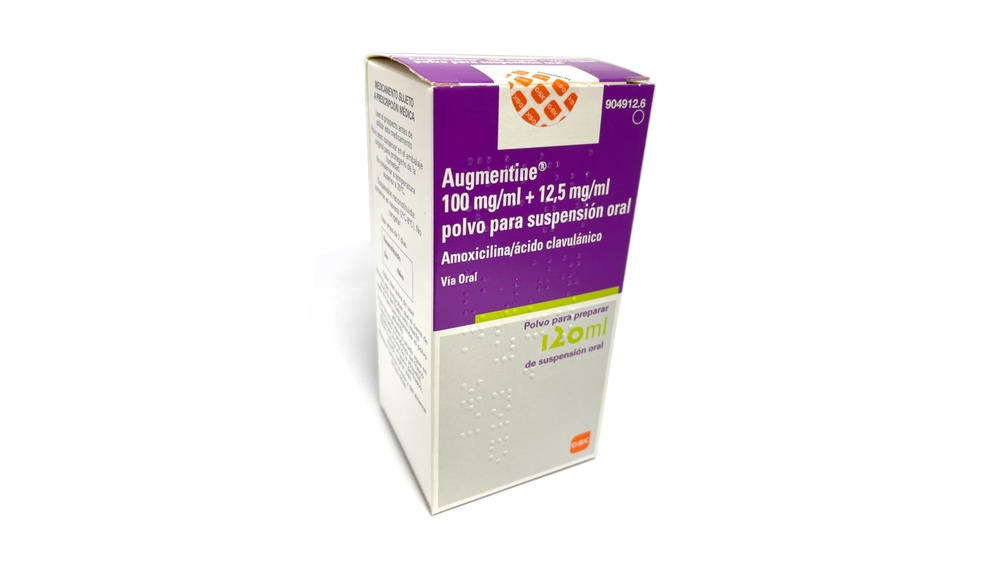
АУГМЕНТИН 100 мг/мл + 12,5 мг/мл ПОРОШОК ДЛЯ ПРИГОТОВЛЕНИЯ ОРАЛЬНОЙ СУСПЕНЗИИ

Спросите врача о рецепте на АУГМЕНТИН 100 мг/мл + 12,5 мг/мл ПОРОШОК ДЛЯ ПРИГОТОВЛЕНИЯ ОРАЛЬНОЙ СУСПЕНЗИИ

Инструкция по применению АУГМЕНТИН 100 мг/мл + 12,5 мг/мл ПОРОШОК ДЛЯ ПРИГОТОВЛЕНИЯ ОРАЛЬНОЙ СУСПЕНЗИИ
Введение
Инструкция: информация для пользователя
Аугментин 100мг/мл + 12,5мг/мл порошок для пероральной суспензии
амоксициллин/клавулановая кислота
Прочитайте внимательно всю инструкцию перед началом приема этого лекарства,поскольку она содержит важную информацию для вас.
- Сохраните эту инструкцию, поскольку вам может потребоваться перечитать ее.
- Если у вас есть какие-либо вопросы, проконсультируйтесь с вашим врачом, фармацевтом или медсестрой.
- Это лекарство обычно назначается детям, и не следует давать его другим людям, даже если они имеют те же симптомы, что и ваш ребенок, поскольку оно может нанести им вред.
- Если ваш ребенок испытывает побочные эффекты, проконсультируйтесь с вашим врачом, фармацевтом или медсестрой, даже если это побочные эффекты, которые не указаны в этой инструкции. См. раздел 4.
Содержание инструкции
- Что такое Аугментин и для чего он используется
- Что нужно знать перед приемом Аугментина
- Как принимать Аугментин
- Возможные побочные эффекты
- Хранение Аугментина
- Содержание упаковки и дополнительная информация
1. Что такое Аугментин и для чего он используется
Аугментин - это антибиотик, который уничтожает бактерии, вызывающие инфекции. Он содержит два разных препарата: амоксициллин и клавулановую кислоту. Амоксициллин относится к группе лекарств, известных как "пенициллины", которые иногда могут потерять свою эффективность (инактивироваться). Другой компонент (клавулановая кислота) предотвращает это.
Антибиотики используются для лечения бактериальных инфекций и не подходят для лечения вирусных инфекций, таких как грипп или простуда. Важно следовать инструкциям относительно дозировки, приема и продолжительности лечения, указанным вашим врачом. Не храните и не повторно используйте это лекарство. Если после окончания лечения у вас осталось антибиотик, верните его в аптеку для правильной утилизации. Не выбрасывайте лекарства в канализацию или мусор. |
Аугментин 100 мг/мл + 12,5 мг/мл порошок для пероральной суспензии используется у взрослых и детей для лечения следующих инфекций:
- инфекции среднего уха и придаточных пазух
- инфекции дыхательных путей
- инфекции мочевыводящих путей
- инфекции кожи и мягких тканей, включая инфекции зубов
- инфекции костей и суставов.
2. Что нужно знать перед приемом Аугментина
Не давайте Аугментин вашему ребенку
- если он аллергичен к амоксициллину, клавулановой кислоте или любому другому компоненту этого лекарства (см. раздел 6)
- если он когда-либо имел тяжелую аллергическую реакцию на любой другой антибиотик. Это может включать кожную сыпь или отек лица или горла
- если он когда-либо имел проблемы с печенью или желтухой (желтый цвет кожи) при приеме антибиотика.
Не давайте Аугментин вашему ребенку, если любой из вышеуказанных пунктов относится к нему. Прежде чем начать лечение Аугментином, если вы не уверены, проконсультируйтесь с вашим врачом или фармацевтом.
Предостережения и меры предосторожности
Проконсультируйтесь с вашим врачом, фармацевтом или медсестрой перед тем, как давать Аугментин вашему ребенку, если:
- у него инфекционный мононуклеоз
- он проходит лечение от проблем с печенью или почками
- он не мочится регулярно.
Если вы не уверены, касается ли вашего ребенка любой из вышеуказанных симптомов, сообщите об этом вашему врачу или фармацевту перед приемом Аугментина.
В некоторых случаях ваш врач может исследовать тип бактерий, вызывающих инфекцию вашего ребенка. В зависимости от результатов ваш ребенок может получить другую форму Аугментина или другое лекарство.
Симптомы, на которые следует обратить внимание
Аугментин может ухудшить определенные существующие состояния или вызвать серьезные побочные эффекты. Это включает аллергические реакции, судороги и воспаление толстой кишки. Вы должны быть осторожны с определными симптомами, пока ваш ребенок принимает Аугментин, чтобы уменьшить риск проблем. См. "Симптомы, на которые следует обратить внимание" в разделе 4.
Анализы крови и мочи
Если вашему ребенку проводятся анализы крови (такие как исследования анализа красных кровяных клеток или анализы для проверки функции печени) или анализы мочи (для контроля уровня глюкозы), сообщите вашему врачу или медсестре, что он принимает Аугментин. Это потому, что Аугментин может изменить результаты этих типов анализов.
Другие лекарства и Аугментин
Сообщите вашему врачу или фармацевту, если ваш ребенок принимает, недавно принимал или может принимать любое другое лекарство.
Если ваш ребенок принимает аллопуринол (используемый для лечения подагры) с Аугментином, он может быть более склонен к аллергической реакции на коже.
Если ваш ребенок принимает пробенецид (используемый для лечения подагры), ваш врач может скорректировать дозу Аугментина.
Если принимаются антикоагулянты (такие как варфарин) с Аугментином, потребуется больше анализов крови.
Аугментин может повлиять на действие метотрексата (лекарства для лечения рака или ревматических заболеваний).
Аугментин может повлиять на то, как работает микофенолат мофетил (лекарство, используемое для предотвращения отказа органов у пациентов после трансплантации).
Беременность, лактация и фертильность
Если ваша дочь будет принимать это лекарство и она беременна или кормит грудью, думает, что может быть беременной или планирует стать беременной, проконсультируйтесь с вашим врачом или фармацевтом перед использованием этого лекарства.
Вождение и использование машин
Аугментин может иметь побочные эффекты, и симптомы могут сделать невозможным вождение.
Не驾驶уйте или не используйте машины, если вы не чувствуете себя хорошо.
Аугментинсодержит аспартам, бензоат натрия, мальтодекстрин и натрий
- Это лекарство содержит 3,2 мг аспартама в каждом мл. Аспартам содержит источник фенилаланина, который может быть вредным в случае фенилкетонурии (ФКН), редкого генетического заболевания, при котором фенилаланин накапливается из-за того, что организм не может правильно его удалить.
- Это лекарство содержит 1,7 мг бензоата натрия на мл. Бензоат натрия может увеличить риск желтухи (желтый цвет кожи и глаз) у новорожденных (до 4 недель жизни).
- Аугментин содержит мальтодекстрин (глюкозу). Если ваш врач сказал вам, что ваш ребенок страдает непереносимостью определенных сахаров, проконсультируйтесь с ним перед приемом этого лекарства.
- Это лекарство содержит менее 23 мг натрия (1 ммоль) на мл; это означает, что оно практически "не содержит натрия".
3. Как принимать Аугментин
Следуйте точно инструкциям по приему этого лекарства, указанным вашим врачом или фармацевтом. В случае сомнений проконсультируйтесь с вашим врачом или фармацевтом.
Взрослые и дети весом40кгили более
- Обычно не рекомендуется для взрослых и детей, вес которых составляет 40 кг или более. Попросите совета у вашего врача или фармацевта.
Дети весом менее 40кг
Все дозы указаны на основе веса ребенка в килограммах.
- Рекомендуемая доза составляет 40 мг/5 мг до 80 мг/10 мг на каждый килограмм веса тела и день, разделенных на три приема.
- Ваш врач посоветует, сколько Аугментина следует давать вашему ребенку.
- Вам будет предоставлена пластиковая ложка или дозировочный шприц. Вы должны использовать его, чтобы давать правильную дозу вашему ребенку. Инструкции по использованию дозировочного шприца приведены в конце этой инструкции.
Пациенты с проблемами почек и печени
- Если у вашего ребенка есть проблемы с почками, может быть снижена доза. Ваш врач может выбрать другую форму Аугментина или другое лекарство.
- Если у вашего ребенка есть проблемы с печенью, будут проведены более частые анализы крови, чтобы проверить, как работает его печень.
Как принимать Аугментин
- Всегда хорошо встряхивайте флакон перед каждым приемом.
- Принимайте с пищей.
- Разделяйте приемы в течение дня, как минимум 4 часа. Не принимайте 2 дозы за 1 час.
- Не давайте Аугментин вашему ребенку более двух недель. Если ваш ребенок продолжает чувствовать себя плохо, он должен снова увидеть врача.
Если вы дадите Аугментин больше, чем следует
Если вы дадите вашему ребенку слишком много Аугментина, могут появиться симптомы, такие как расстройство желудка (тошнота, рвота, диарея или судороги).
В случае передозировки или случайного приема проконсультируйтесь с вашим врачом или фармацевтом или позвоните в Центр токсикологической информации, телефон: 91 562 04 20, указав лекарство и количество, принятое.
Если вы пропустите прием Аугментина
Если вы забудете дать вашему ребенку дозу, дайте ее как можно скорее. Не давайте следующую дозу слишком быстро, подождите как минимум 4 часа перед тем, как дать следующую дозу. Не принимайте двойную дозу, чтобы компенсировать пропущенные дозы.
Если ваш ребенок прекратит лечение Аугментином
Продолжайте давать Аугментин вашему ребенку до окончания лечения, даже если он чувствует себя лучше. Вашему ребенку необходимо пройти полный курс лечения, чтобы помочь ему бороться с инфекцией. Если бактерии выживут, инфекция вернется.
Если у вас есть какие-либо другие вопросы о использовании этого лекарства, проконсультируйтесь с вашим врачом, фармацевтом или медсестрой.
4. Возможные побочные эффекты
Как и все лекарства, это лекарство может вызывать побочные эффекты, хотя не все люди испытывают их. Побочные эффекты, указанные ниже, могут возникнуть при приеме этого лекарства.
Симптомы, на которые следует обратить внимание
Аллергические реакции:
- кожная сыпь
- воспаление кровеносных сосудов (васкулит), которое может появиться как красные или фиолетовые точки на коже, но также может повлиять на другие части тела
- лихорадка, боль в суставах, опухание лимфатических узлов на шее, в подмышках или паху
- отек, иногда на лице или горле (ангиоэдема), который вызывает затруднение дыхания
- коллапс
- боль в груди в контексте аллергических реакций, которая может быть симптомом инфаркта миокарда, вызванного аллергией (синдром Куниса).
- Обратитесь к вашему врачу немедленно, если ваш ребенок испытывает любой из этих симптомов. Прекратите давать Аугментин.
Воспаление толстой кишки
Воспаление толстой кишки, которое вызывает водянистую диарею, обычно с кровью и слизью, боль в животе и/или лихорадку.
Синдром лекарственного энтероколита (ДИЕС)
ДИЕС был зарегистрирован в основном у детей, получавших амоксициллин/клавулановую кислоту. Это определенный тип аллергической реакции с основным симптомом повторной рвоты (от 1 до 4 часов после приема лекарства). Другие симптомы могут включать боль в животе, вялость, диарею и низкое кровяное давление.
Острое воспаление поджелудочной железы (острый панкреатит)
Если у вас сильная и постоянная боль в области живота, это может быть признаком острого панкреатита.
- Свяжитесь с вашим врачом как можно скорее, чтобы он посоветовал, что делать, если ваш ребенок испытывает эти симптомы.
Очень частые побочные эффекты
Могут возникнуть у более 1 из 10 человек
- диарея (у взрослых).
Частые побочные эффекты
Могут возникнуть у до 1 из 10 человек
- афты (Candida– инфекция, вызванная грибами, в вагине, рту или на слизистых оболочках)
- тошнота, особенно при приеме высоких доз
- если это происходит, принимайте Аугментин с пищей
- рвота
- диарея (у детей).
Побочные эффекты, возникающие нечасто
Могут возникнуть у до 1 из 100 человек
- кожная сыпь, зуд
- увеличенная зудящая сыпь (уртикарный зуд)
- изжога
- головокружение
- головная боль.
Побочные эффекты, возникающие нечасто, которые могут возникнуть в анализах крови:
- увеличение некоторых веществ (ферментов), производимых печенью.
Редкие побочные эффекты
Могут возникнуть у до 1 из 1 000 человек
- кожная сыпь, которая может образовывать пузырьки, похожие на маленькие мишени (центральная точка темнее, окруженная более светлой областью, с темной полосой вокруг края - эритема многоформная).
- Если у вас есть любой из этих симптомов, проконсультируйтесь с врачом немедленно.
Побочные эффекты, возникающие редко, которые могут возникнуть в анализах крови:
- низкий уровень кровяных клеток, участвующих в свертывании крови
- низкий уровень белых кровяных клеток.
Частота не известна
Частота не может быть оценена на основе доступных данных.
- аллергические реакции (см. выше)
- воспаление толстой кишки (см. выше)
- воспаление оболочек, окружающих мозг и спинной мозг (асептический менингит)
- тяжелые кожные реакции:
- общая сыпь с пузырьками и отслоением кожи, особенно вокруг рта, носа, глаз и гениталий (синдром Стивенса-Джонсона) и в его наиболее тяжелой форме, вызывающая общее отслоение кожи (более 30% поверхности тела - токсический эпидермальный некролиз)
- общая сыпь с небольшими пузырьками и гноем (буллезный эксфолиативный дерматит)
- красная сыпь с бугорками под кожей и крапивницей (пустулезный эксантем)
- симптомы, похожие на грипп, с кожной сыпью, лихорадкой, воспалением лимфатических узлов и аномальными результатами анализов крови (такими как увеличение количества лейкоцитов (эозинофилия) и повышение печеночных ферментов) (лекарственный синдром с эозинофилией и системными симптомами (DRESS))
- красная сыпь, обычно наблюдаемая на обеих сторонах ягодиц, на внутренней поверхности бедер, в подмышках, на шее (симметричный интертригинозный и сгибательный экзантем, связанный с лекарствами (SDRIFE)).
- Обратитесь к врачу немедленно, если ваш ребенок испытывает любой из этих симптомов.
- сыпь с пузырьками, расположенными в круге с центральной коркой или как ожерелье (болезнь, вызванная IgA)
- воспаление печени (гепатит)
- желтуха, вызванная увеличением билирубина в крови (вещества, производимой печенью), которая может сделать кожу и белки глаз желтыми
- воспаление мочеточников
- замедление свертывания крови
- гиперактивность
- судороги (у пациентов, принимающих высокие дозы Аугментина или имеющих проблемы с почками)
- черный язык, похожий на волосатый
- пятна на зубах (у детей), которые обычно исчезают после чистки.
Побочные эффекты, которые могут возникнуть в анализах крови или мочи:
- значительное снижение количества белых кровяных клеток
- низкий уровень красных кровяных клеток (гемолитическая анемия)
- кристаллы в моче, которые могут вызвать острую почечную травму.
Сообщение о побочных эффектах
Если вы испытываете любой побочный эффект, проконсультируйтесь с вашим врачом или фармацевтом, даже если это возможные побочные эффекты, которые не указаны в этой инструкции. Вы также можете сообщить об этом напрямую через Испанскую систему фармакологического надзора за лекарствами для человека, http://www.notificaRAM.es. Сообщая о побочных эффектах, вы можете внести свой вклад в предоставление более полной информации о безопасности этого лекарства.
5. Хранение Аугментина
Храните это лекарство в недоступном для детей месте.
Сухой порошок
Не храните при температуре выше 25°C. Храните в оригинальной упаковке, чтобы защитить от влаги.
Не используйте это лекарство после даты истечения срока годности (CAD), указанной на упаковке. Дата истечения срока годности - последний день месяца, указанного.
Жидкая суспензия
Храните в холодильнике (между 2°C и 8°C). Не замораживайте.
После восстановления суспензия должна быть использована в течение первых 7 дней.
Лекарства не должны быть выброшены в канализацию или мусор. Поместите упаковку и лекарства, которые вам больше не нужны, в пункт SIGRE аптеки. Если у вас есть сомнения, спросите у вашего фармацевта, как избавиться от упаковки и лекарств, которые вам больше не нужны. Таким образом, вы поможете защитить окружающую среду.
6. Содержимое упаковки и дополнительная информация
Состав Аугментина100мг/мл + 12,5мг/мл порошок для пероральной суспензии
- Активные вещества - амоксициллин и клавулановая кислота. Каждый мл суспензии содержит амоксициллин тригидрат, эквивалентный 100 мг амоксициллина, и клавуланат калия, эквивалентный 12,5 мг клавулановой кислоты.
- Другие компоненты (вспомогательные вещества) - стеарат магния, аспартам (E951), кросповидон, камедь ксантановая, коллоидная гидратированная диоксид кремния, коллоидная безводная диоксид кремния, бензоат натрия (E211), кармеллоза натрия, ароматизатор клубники (содержит мальтодекстрин).
- См. раздел 2 для получения более подробной информации об аспартаме (E951), бензоате натрия (E211), мальтодекстрине и натрии в Аугментине.
Внешний вид продукта и содержимое упаковки
Аугментин 100 мг/мл + 12,5 мг/мл порошок для пероральной суспензии - белесый порошок, который
представлен в прозрачных стеклянных флаконах объемом 45, 107 или 147 мл. После восстановления флакон может содержать 30 мл, 40 мл, 60 мл или 120 мл жидкой белесой смеси, называемой суспензией.
Возможно, что будут продаваться только некоторые размеры упаковок.
Упаковки объемом 40 мл включают дозирующую систему, а упаковка объемом 120 мл - ложку, чтобы облегчить введение продукта.
Владелец разрешения на маркетинг и производитель
Владелец разрешения на маркетинг:
GlaxoSmithKline, S.A.
P.T.M. – C/ Severo Ochoa, 2
28760 Tres Cantos (Мадрид)
Тел: +34 900 202 700
Производитель:
Glaxo Wellcome Production
Z.I. de la Peyenniere
53101 Mayenne
Cedex - Франция
Этот препарат разрешен в государствах-членах Европейского экономического пространства под следующими названиями:
Франция – Аугментин
Германия - Аугментан
Нидерланды – Аугментин
Испания - Аугментин
Дата последнего пересмотра этой инструкции:май 2024 г.
Подробная информация о этом препарате доступна на сайте Агентства по лекарственным средствам и медицинским изделиям Испании (AEMPS) http://www.aemps.gob.es
---------------------------------------------------------------------------------------------------------------
Инструкции по восстановлению
Удалить крышку флакона. Проверить, что алюминиевое уплотнение целое перед использованием продукта. Вернуть крышку флакона.
- Встряхнуть флакон, чтобы отделить прилипший порошок.
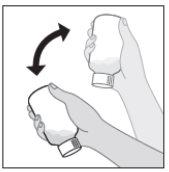
- Удалить крышку флакона.
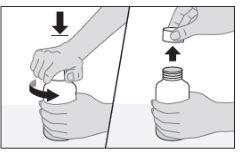
- Удалить алюминиевое уплотнение.
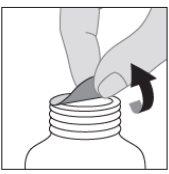
- Добавить объем воды (как показано в таблице ниже). Вернуть крышку флакона, перевернуть и хорошо встряхнуть еще раз.
Концентрация | Объем воды для восстановления (мл) | Окончательный объем восстановленной суспензии (мл) |
100 мг/мл + 12,5 мг/мл | 26 | 30 |
34 | 40 | |
52 | 60 | |
103 | 120 |
Альтернативно, встряхнуть флакон, чтобы отделить прилипший порошок, затем наполнить водой до отметки на флаконе (для флаконов объемом 30, 60, 120 мл) или до отметки на этикетке флакона (для флаконов объемом 40 мл). Вернуть крышку флакона, перевернуть и хорошо встряхнуть. Затем снова наполнить водой точно до отметки или метки. Вернуть крышку флакона, перевернуть и хорошо встряхнуть еще раз.
Инструкции по использованию дозирующей системы (для флаконов объемом 40мл)
Дозирующая система предоставляется для введения Аугментина
Дозирующая система предназначена только для использования с Аугментином и не должна использоваться для введения других препаратов, поскольку метки на дозирующей системе специфичны для этого продукта. Дозирующая система поставляется с адаптером, который позволяет присоединить ее к флакону.
Доза указана на дозирующей системе в мл. Вы должны дать ребенку рекомендованную врачом дозу.
Проверить чистоту дозирующей системы и адаптера перед использованием; промыть чистой водой, если необходимо.
- Встряхнуть хорошо флакон с восстановленной суспензией перед каждым использованием.
.
- Удалить адаптер из дозирующей системы. Взять флакон крепко и вставить адаптер в горлышко флакона (адаптер должен остаться на месте).
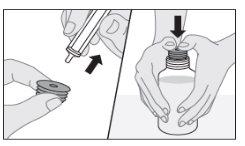
- Вставить дозирующую систему в адаптер, убедившись, что она хорошо закреплена.
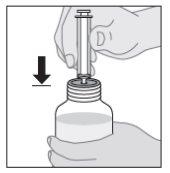
- Перевернуть флакон, держа дозирующую систему, и удалить необходимую дозу, указанную врачом.
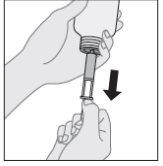
- Поставить флакон вверх и удалить дозирующую систему.
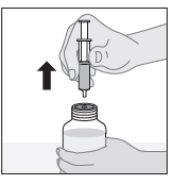
- Чтобы ввести дозу, осторожно поместить кончик дозирующей системы в рот и медленно нажать на поршень дозирующей системы (повторить шаги 3, 4, 5 и 6, если необходимо использовать более одной дозирующей системы для введения дозы).
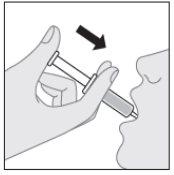
- Тщательно промыть дозирующую систему чистой водой. Дать дозирующей системе полностью высохнуть перед повторным использованием.
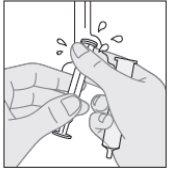
- Вернуть крышку флакона.
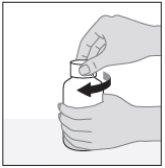
- Хранить в холодильнике и всегда встряхивать перед использованием.
После восстановления суспензия должна быть использована в течение 7 дней.

Сколько стоит АУГМЕНТИН 100 мг/мл + 12,5 мг/мл ПОРОШОК ДЛЯ ПРИГОТОВЛЕНИЯ ОРАЛЬНОЙ СУСПЕНЗИИ в Испании в 2025 году?
Средняя цена на АУГМЕНТИН 100 мг/мл + 12,5 мг/мл ПОРОШОК ДЛЯ ПРИГОТОВЛЕНИЯ ОРАЛЬНОЙ СУСПЕНЗИИ в декабрь, 2025 года составляет около 8.74 евро. Финальная стоимость может зависеть от региона, конкретной аптеки и рецептурного статуса. Для точной информации лучше проверить онлайн или в ближайшей аптеке.
- Страна регистрации
- Средняя цена в аптеках8.74 EUR
- Активное вещество
- Требуется рецептДа
- Производитель
- Информация носит справочный характер и не является медицинской рекомендацией. Перед приемом любых препаратов проконсультируйтесь с врачом. Oladoctor не несет ответственности за медицинские решения, принятые на основе этого контента.
- Аналоги АУГМЕНТИН 100 мг/мл + 12,5 мг/мл ПОРОШОК ДЛЯ ПРИГОТОВЛЕНИЯ ОРАЛЬНОЙ СУСПЕНЗИИФорма выпуска: ОРАЛЬНЫЙ РАСТВОР/СУСПЕНЗИЯ, 250 мг амоксициллина/62,5 мг клавулановой кислотыАктивное вещество: amoxicillin and beta-lactamase inhibitorПроизводитель: Sandoz Farmaceutica S.A.Требуется рецептФорма выпуска: ИНЪЕКЦИОННЫЙ РАСТВОР ДЛЯ ИНФУЗИЙ, 2 г / 200 мгАктивное вещество: amoxicillin and beta-lactamase inhibitorПроизводитель: Laboratorio Reig Jofre, S.A.Требуется рецептФорма выпуска: ТАБЛЕТКА, 500 мг амоксициллина/125 мг клавулановой кислотыАктивное вещество: amoxicillin and beta-lactamase inhibitorПроизводитель: Sun Pharmaceutical Industries (Europe) B.V.Требуется рецепт
Аналоги АУГМЕНТИН 100 мг/мл + 12,5 мг/мл ПОРОШОК ДЛЯ ПРИГОТОВЛЕНИЯ ОРАЛЬНОЙ СУСПЕНЗИИ в других странах
Лучшие аналоги с тем же действующим веществом и терапевтическим эффектом.
Аналог АУГМЕНТИН 100 мг/мл + 12,5 мг/мл ПОРОШОК ДЛЯ ПРИГОТОВЛЕНИЯ ОРАЛЬНОЙ СУСПЕНЗИИ в Poland
Аналог АУГМЕНТИН 100 мг/мл + 12,5 мг/мл ПОРОШОК ДЛЯ ПРИГОТОВЛЕНИЯ ОРАЛЬНОЙ СУСПЕНЗИИ в Ukraine
Врачи онлайн по АУГМЕНТИН 100 мг/мл + 12,5 мг/мл ПОРОШОК ДЛЯ ПРИГОТОВЛЕНИЯ ОРАЛЬНОЙ СУСПЕНЗИИ
Консультация по дозировке, побочным эффектам, взаимодействиям, противопоказаниям и продлению рецепта на АУГМЕНТИН 100 мг/мл + 12,5 мг/мл ПОРОШОК ДЛЯ ПРИГОТОВЛЕНИЯ ОРАЛЬНОЙ СУСПЕНЗИИ – по решению врача и с учетом местных правил.















